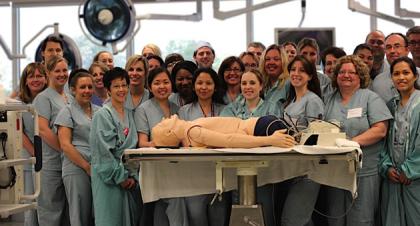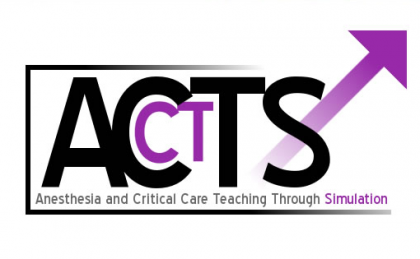Simulating Operating Room Emergencies to Increase Patient Safety
Tuesday, August 13, 2013
Simulating operating room emergencies to increase patient safety
August 9, 2013
Properly using a defibrillator, managing a code blue in the post-anesthesia care unit (PACU), and performing an emergency tracheostomy were just some of the skills operating room nurses and anaesthesiologists practiced during a one-day simulation training session recently held at the Canadian Surgical Technologies & Advanced Robotics (CSTAR) facility in University Hospital (UH).
“We held the training on a Saturday and the response from staff really demonstrates their commitment to their profession and patient safety,” says David Remy, coordinator, operating suites, UH.

24 nurses practiced emergency scenarios along with anaesthesiologists in a simulated environment at CSTAR to increase patient safety during real OR emergencies.
24 mostly newly hired nurses from University Hospital and Victoria Hospital were separated into groups and moved between four training stations with an anesthesiologist at each station. Two of the stations utilized SimMan, a patient simulator, and two made use of people role playing. Each station offered an opportunity to safely work through a medical emergency before facing that situation in the operating room.
“Ahead of the training day, anaesthesiologists had an opportunity to choose the emergency scenarios they felt would offer the best learning experience for themselves and the nurses,” says Dr. Richard Cherry, anesthetist, LHSC. “The goal of the training was to increase patient safety during an emergency by providing staff an opportunity to hone their skills in a safe environment while focusing on effective communication between disciplines.”
Everyone who participated signed an agreement to ensure that performance during the training remained confidential. “We wanted to foster a safe learning environment and to encourage discussion,” adds Edward McGowan, coordinator, operating suites, UH. A debrief session was held after each simulation exercise to discuss the scenario, look for strengths and areas of improvement, and provide an opportunity to understand the logic behind the decisions of everyone involved. Participants identified the debrief sessions as one of the most beneficial aspects of the training.
Each participant received a formal certificate of participation which will be added to their personnel file. “Simulation training combines learning theory with the emotional experience of working on a scenario in an interdisciplinary environment to ideally help participants retain the knowledge and experience they gain,” continues Cherry.
Another session is currently being tentatively planned for late Fall. “We hope to include even more disciplines including respiratory therapists and other operating room staff,” announces Remy.
Dr. Richard Cherry is the Director of the ACCTTS (Anesthesia and Critical Care Teaching Through Simulation) Program. Visit the ACCTTS Program Page today to learn more about their groundbreaking work.









